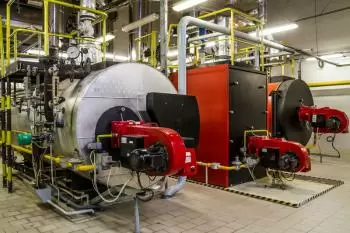
A boiler is a device used to heat water or another fluid by burning fuel or using electric energy. Its main purpose is to transfer heat to the fluid contained within it, which is then used in industrial processes, heating systems or steam generation.
Boilers can run on a variety of fuels, including natural gas, diesel, coal, biomass, electricity and even nuclear power. Below, we explore how they work and the main types that exist.
How a boiler works
The operation of a boiler is based on the transfer of heat from an energy source to a fluid, usually water, to generate steam or hot water.
First, the fuel (gas, biomass, electricity or waste energy) is burned in the furnace or combustion chamber , producing hot gases. These gases travel through a system of heat exchanger tubes , giving up their energy to the water contained inside the boiler.
Depending on the type of boiler, the water may be in direct contact with the combustion gases (fire tube boilers) or circulate through tubes surrounded by these gases (water tube boilers).
As the water absorbs heat, its temperature increases until it reaches the boiling point, turning into steam if it is a steam boiler or simply heating up if it is a heating boiler.
In steam boilers, this steam is collected at the top of the vessel and distributed through pipes for use in various industrial or energy applications. In the case of heating boilers, the hot water is pumped to a distribution system, such as radiators or underfloor heating.
To ensure safe and efficient operation, boilers include control devices such as safety valves, thermostats, pressure sensors and purge systems , which regulate the temperature and pressure of the system, avoiding overloads or risks of explosion.
Steam boilers
Steam boilers generate saturated steam at a constant pressure, allowing their use in various industrial processes. They operate on the principle of heat transfer, where the fluid, initially in a liquid state, is heated until it changes phase.
Classification of steam boilers
Depending on their design and application, steam boilers can be divided into several types:
Fire tube boilers
In this type of boiler, combustion gases circulate inside tubes submerged in water, transferring heat to the fluid until it is converted into steam. They are used in low and medium pressure applications, such as in small industrial processes and building heating systems, due to their simplicity and lower operating cost.
Water tube boilers
They work in the opposite way to fire tube boilers, as the water circulates inside the tubes while the hot gases surround them. They are more efficient and can reach higher pressures and temperatures, which is why they are used in power plants and large industrial processes that require a large production of steam.
Heat recovery boilers
These boilers do not have their own burner, but instead use the residual heat from other processes, such as gas turbines or industrial furnaces, to generate steam. They are essential in cogeneration and combined cycle plants, where they allow increased energy efficiency by reusing energy that would otherwise be wasted.
Applications of steam boilers
Steam boilers are essential in many sectors, such as:
- Sterilization in hospitals and laboratories.
- Heating of industrial fluids. In refineries and chemical plants.
- Electricity generation. Through the Rankine cycle in thermal power plants.
- Textile and food industry. In processes such as fabric dyeing or pasteurization.
It is important to differentiate between a steam boiler and a steam generator . While the boiler produces saturated steam (at saturation temperature), the steam generator creates superheated steam , useful in processes that require higher temperature and efficiency.
Heating boilers
Heating boilers are designed to generate hot water used in central heating systems and in the production of domestic hot water (DHW) . They are used in homes as well as in industrial and commercial buildings.
Types of heating boilers
Depending on the power source and design, they can be classified as:
Gas boilers
These are the most common in homes and buildings, using natural gas or propane as fuel to heat water, which is then distributed to radiators or underfloor heating systems. They are efficient, economical and have a fast thermal response, although they require a connection to the gas network or storage tanks.
Biomass boilers
They use organic fuels such as pellets, wood chips or agricultural waste, making them a sustainable and ecological option. They are ideal for rural areas or places without access to gas, although they require more storage space and regular maintenance for cleaning ash and waste.
Condensing boilers
Designed to maximise efficiency, these boilers take advantage of the latent heat of the water vapour contained in the combustion gases, reducing fuel consumption and polluting emissions. They are an excellent option for modern homes with low-temperature heating systems, such as underfloor heating.
Electric boilers
They work by means of electric resistors that heat the water without the need for combustion, which makes them safe, silent and easy to install. However, their energy consumption is high, which is why they are usually used in homes with advantageous electricity rates or as a support in hybrid heating systems.
Applications of heating boilers
- Heating of buildings and homes. Using radiators, underfloor heating or air systems.
- Domestic hot water (DHW). In homes, hospitals and hotels.
Fuels used in boilers
The heat source in a boiler can come from various fuels:
- Fossils : Natural gas, diesel, coal.
- Biomass : Pellets, wood chips, organic waste.
- Electricity : In electric resistance or induction boilers.
- Nuclear : Through nuclear fission , used in boiling water reactors ( BWR ) and pressurized water reactors ( PWR ).
- Waste heat : Some industries utilize the rejected heat from gas turbines using heat recovery steam generators (HRSG) .